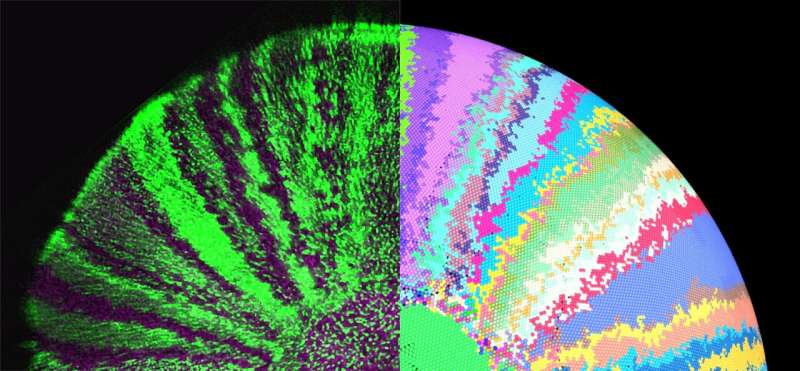Scientists shine new light on how cells coordinate eye growth in fish

New insight on how cells work together to control growth in the eyes of fish has been published today in eLife.
The study suggests a system where cells in the neural retina of Japanese rice fish (also known as the medaka) give orders to cells in the retinal pigment epithelium, to ensure the eyes develop properly in these animals. The findings add to our understanding of how cells can coordinate organ growth, and show how random chance and the location of cells within certain tissues play a role in this process.
Plants and animals grow by making more cells. Stem cells are crucial to this process as they are able to create copies of themselves when needed. For organisms to maintain the correct proportions, growth must be regulated at the level of the whole body and the sizes of each organ and tissues within an organ.
In the fish eye, the tissue that sees light (the neural retina) and the tissue that supports it (the retinal pigment epithelium) have their own stem cells that do not mix together. When these different tissues grow, they must do so at exactly the same speed, otherwise the eyes could develop wrinkles that would cause poor eyesight in the animals.
"The coordinated growth of multiple independent tissues exists in all living organisms, and is important not only for growth, but also for healing wounds and replacing dead cells," explains first author Erika Tsingos, a doctoral student at Heidelberg University's Centre for Organismal Studies (COS), Germany. "When this control goes awry, it can lead to diseases including cancer. It's therefore important to understand how tissues normally agree on making new cells, and how random chance and a cells' surroundings can change the situation. In our study, we used the medaka fish to see how stem cells in the neural retina and retinal pigment epithelium agree on creating new cells at the precise time they're needed."
To do this, the team combined a computational model with a technique called clonal analysis, which involves mapping out the descendants of a single cell to build a 'cell family tree'. Their analysis revealed that stem cells in the neural retina act as a kind of boss during growth, telling the stem cells in the retinal pigment epithelium when to create more cells. The cells in the retinal pigment epithelium go through periods of minimal division, apparently waiting for cues from the neural retina cells before making more cells as needed.
Strikingly, the team also discovered that random stem-cell loss occurs in the medaka eye, and is differentially fine-tuned in the neural retina and retinal pigmented epithelium tissue to allow for proper development.
"Our results reveal an unappreciated mechanism for growth coordination, where one tissue gives cues to synchronise the growth of nearby tissues," says senior author Joachim Wittbrodt, Professor of Developmental Biology at Heidelberg University's COS. "Such a strategy might have evolved more generally in organ development across a range of other animals and plants.
"This basic research highlights the chain of command among healthy tissues, and may help guide future studies on how these interactions break down in disease," Wittbrodt adds. "Our aim now is to study how cells in the retinal pigment epithelium interpret the cues from the neural retina to tune down their rate of cell division."
More information: Erika Tsingos et al, Retinal stem cells modulate proliferative parameters to coordinate post-embryonic morphogenesis in the eye of fish, eLife (2019). DOI: 10.7554/eLife.42646
Journal information: eLife
Provided by eLife




















